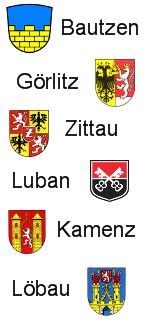The Oberlausitz Six-City-League

To protect the general peace of the Oberlausitz the towns of Bautzen, Görlitz, Kamenz, Lauban, Löbau and Zittau united on the 21st August 1346 to form defensive alliance, which was directed mainly in the beginning towards the robber barony. In the very beginning a more or less loose 'eight-alliance', the six-city league developed into a institution that influenced the region's history over the centuries decisively and would survive all other city alliances. The coalition leads to a substantial prestige boost and political power of all participating cities. It is not impossible that the founding proposed by Charles IV to create a counter balance to the squiredom. He recognised the Oberlausitz Six-City-League in 1351 and came himself to the Oberlausitz in 1355, where he ordered the destruction of the ostracized robber nests by the cities. Destroyed were among others: Tollenstein, Oybin, Landeskrone and Falkenstein.

Opposite to other regions there was never a district dominating town, apart from the time before the 12tn century when Bautzen as old ancestral seat of the Milzener (Land Budissin), was the only place worth mentioning. Even though Bautzen was the administrative centre and Görlitz over many centuries the economically strongest and most populated town, the difference of importance was never that big that there was a dominating centre for the region. But in the Oberlausitz Six-City-League a bifurcating can be recognised into the three 'larger' more powerful cities (Görlitz, Bautzen, Zittau) and the three 'smaller' cities (Löbau, Kamenz, Lauban) but in principle all cities are equal in the alliance.
Outer borough of the alliance was Bautzen. It acted as chairman and had the first vote in the senate. Until the middle of the 14th century Bautzen was also leading economical and in the areas of culture and education. Bautzen had the right to under seal all issued letters and open all incoming writs in the name of the six cities. This lead later sometimes to conflicts with Görlitz, who was economical superior latest since the beginning of the 15th century. Important for Bautzen was also that it was seat of the bailiff, the representative of governmental power and the king's governor, who united the upper military, administrative and legal power.

